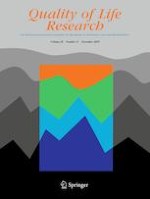18-07-2019 | Brief Communication
A comparison of self-rated health using EQ-5D VAS in the United States in 2002 and 2017
Gepubliceerd in: Quality of Life Research | Uitgave 11/2019
Log in om toegang te krijgenAbstract
Purpose
To compare self-rated health among the United States general population in 2002 and 2017.
Methods
Secondary data were analyzed from two EQ-5D valuation studies conducted in 2002 and 2017. Both studies included the EQ-5D-3L self-classifier and visual analog scale (VAS), where health is rated from 0 (worst imaginable health) to 100 (best imaginable health). VAS scores were compared between time points using regression models, adjusting for sociodemographic factors (Model 1), plus illness (Model 2), and health problems according to the EQ-5D classifier (Model 3).
Results
Mean VAS scores in 2002 [84.4 (SD = 16.1)] were not different from 2017 [84.6 (SD = 14.5)] (p = 0.63), nor different after adjusting for demographics (Model 1) or illness (Model 2). However, 2017 VAS mean scores were significantly higher than 2002 [2.2 (95% CI 1.36–3.10)] upon adjusting for the presence of dimension-specific health problems.
Conclusions
Self-rated health of the general US adult population in 2017 was similar to 2002, but after adjusting for health problems, scores were slightly higher in 2017. Sociodemographic shifts in age and education explain some of the differences in scores, and by removing health and sociodemographic factors, we found the VAS reveals self-rated health is slightly better in 2017 than 2002.
